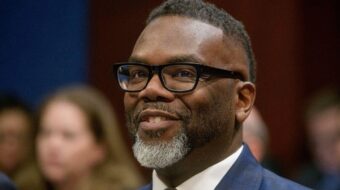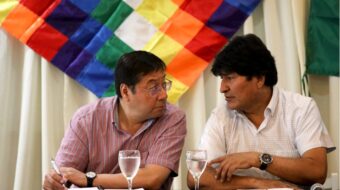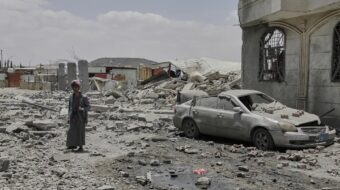PANAMA CITY, Panama — Hundreds of Panamanians rallied here on Dec. 20 to observe the 15th anniversary of the U.S. invasion of their country and to express their growing concern about the Pentagon’s increased activity in the region. They also protested government plans to privatize their social security system.
A number of groups, led by the Alternativa Patriotica Popular coalition, gathered downtown at Parque Porras, near El Chorrillo, an impoverished neighborhood that was one of the hardest hit during the bombing campaign that began the invasion by some 26,000 U.S. troops in 1989. Up to 4,000 Panamanians were killed in the attack.
Pentagon officials have said that its Panama operation, which included a massive bombing campaign followed by a ground invasion to oust then-military dictator and former CIA agent Manuel Noriega from power, served as a model for its recent invasion of Iraq.
Father Conrado Sanjur, a leading Panamanian liberation theologian and human rights activist with the National Liberation Movement-29, led the ceremony, as hundreds of students joined rural laborers from the interior, the Professors’ Association, and SUNTRACS, the nation’s leading construction workers union.
Other Panamanians took their annual pilgrimage to the cemeteries and sites of mass burials where their relatives lay among the thousands killed during the invasion.
“In the years after the invasion, we had hundreds of thousands of people at these protests, but since then [the U.S. troop pullout in 2000], people have begun to forget,” said Henry Rodriguez, a student leader with Pensamiento y Accion Transformadora (Action Transforming Thought).
At the same time, a growing number of Panamanians are perturbed at what they see as the buildup of U.S. military presence in the region. The U.S. plans to send 3,000 troops to Panama by February. Nine hundred Panamanian police are being trained at the Western Hemisphere Institute for Security Cooperation (formerly School of the Americas) in Ft. Benning, Ga. Further, in 2004 the U.S. doubled its troop presence in nearby Colombia to 800, and the number of mercenaries from the U.S. substantially increased there.
“After having seen U.S. war in our homeland for so long, and witnessing the ruthless actions in places like Iraq and Afghanistan, we condemn the reintroduction of U.S. military personnel to our shores,” said Arturo de Leon of the Popular University Bloc, a Marxist student group that was well represented at the protests. Polls indicate some 95 percent of Panamanians opposed the invasion of Iraq.
Another sore spot here has been the evident refusal of the U.S. to fulfill its 1977 treaty obligations to clean up all unexploded bombs and chemical weapons of mass destruction in the former Canal Zone and on Panama’s island of San Juan. Some two dozen people have been killed by this residual ordnance, a legacy of the 150-year-long occupation of the country by the U.S. that formally ended only five years ago. Panama’s government has become increasingly impatient with U.S. Ambassador Linda Watts and Secretary of Defense Donald Rumsfeld on this issue.
Panamanians are also alarmed by the coercive austerity measures being imposed on them, particularly attempts by the government, under the auspices of the International Monetary Fund, to privatize social security.
The government’s actions have provoked a strong reaction, bringing hundreds of thousands of people into the streets in late 2003, and leading to two attempted general strikes. A week before the anniversary of the invasion, workers and students once again marched in defense of social security and fought pitched street battles with police. The issue was again center stage at the Dec. 20 action.
urbanguerrilla@journalist.com









